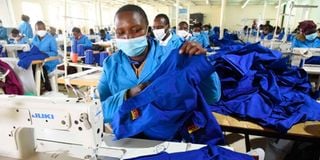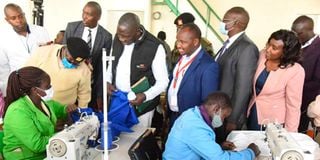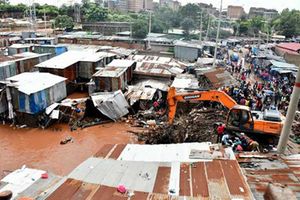Ailing Rivatex limps to the red, blames cotton scarcity

Workers at Rivatex East Africa Limited in Eldoret town, Uasin Gishu County making police uniforms during a visit by Government Spokesman Col. (rtd), Cyrus Oguna on June 21, 2022.
What you need to know:
- In the 2019-2020 budget, the firm was allocated Sh1.1 billion.
It requires more than 500,000 acres of cotton to realise steady supply of raw materials to support smooth operations.
Eldoret-based textile manufacturer Rivatex East Africa Ltd is operating below capacity despite the government and development partners pumping over Sh7 billion for its revival over the past two decades.
Rivatex faces enormous administrative and financial challenges, according to the latest report by Auditor-General Nancy Gathungu, with the management blaming its woes on a shortage of cotton.
Rivatex General Manager (Corporate Services) Patrick Nyaga said the firm receives only 3,000 bales of cotton per month against a capacity of 20,000.
“Just like other textile firms in the country, the company is faced with a serious shortage of cotton and has to import the raw material from East Africa Community member states,” Mr Nyaga told the Nation yesterday.
The company last month sacked more than 50 contract workers amid claims of corruption, nepotism and cash flow challenges. Rivatex was bought by Moi University for Sh205 million in 2007 after it was placed under receivership more than 10 years ago.
It secured a Sh3 billion loan last year from the Indian government and an additional Sh3 billion from the National Treasury to replace its obsolete machines.
Allocated Sh1.1 billion
In the 2019-2020 budget, the firm was allocated Sh1.1 billion.
The management has, however, sought to downplay the firm’s woes.
“We have no delays in salaries nor low morale among the staff. I signed a cheque for statutory deductions last week,” said Mr Nyaga. Kenya produces an average of 5,300 tonnes of lint against a demand of about 38,000 tonnes monthly, with the deficit — worth about Sh17 billion — being imported from neighbouring countries, Mr Nyaga said.

Government Spokesman Col. (rtd), Cyrus Oguna (centre), during a visit at Rivatex East Africa Limited in Eldoret town, Uasin Gishu County on June 21, 2022.
According to Mr Nyaga, the textile firm is expected to increase cotton consumption from 10,000 bales per day against a projected capacity of 100,000, translating to a daily production rate of 40,000 metres, up from the previous 5,000.
It requires more than 500,000 acres of cotton to realise steady supply of raw materials to support smooth operations.
“We do not have sufficient Bt cotton seeds in the market, which means that we are recycling conventional seeds leading to low productivity,” Mr Nyaga said, adding that the company is supporting cultivation of cotton by counties in the North Rift region.
“Although we have invested in Bt cotton, production is insufficient to support our operations,” added Mr Nyaga. He said the acreage under Bt cotton increased from 33,193 to 149,000 but production remained at 10,000 bales annually which is too low to sustain operations.
“The production is like a drop in the ocean considering that demand outstrips supply for many textile firms in the country,” added Mr Nyaga. The government recently injected Sh650 million for modernisation of the firm.
Under receivership
The company used to produce a total of 15.73 metres of fabric before it was placed under receivership in 2000 following massive administration and financial mismanagement.
It consisted of 5.5 million metres of dyed cotton and 7.7 million of printed cotton, as well as 1.17 and 0.55 million metres of dyed and printed polyester/viscose respectively.
According to Mr Nyaga, the genetically modified Bt cotton variety, which is resistant to ball worm pests, is undergoing pilot testing in traditional cotton growing regions and once approved, will guarantee a steady supply of raw materials for textile manufacturers.
“The trial for cultivation of Bt cotton is ongoing in six counties — Busia, Baringo, Tana River, Kirinyaga, Makueni and Meru,” Mr Nyaga said. The North Rift region produced 852.60 tonnes of cotton on 794.5 hectares last season.





